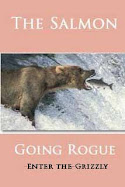
I started flight training with an instructor named Mike. We flew in an old Cessna 152, a little 2 seater with a hundred-horse engine that when loaded with fuel and 2 adults struggled to get off the runway. The interior was threadbare from all the students that had flown her before me.
The first few lessons had gone very well. It was on my 5th flight that Mike took over the controls and decided that it was time to introduce me to stalls.
For the non-pilot there is often a misconception of what it means when they hear that a plane stalls, often assuming that the engine has died and the plane subsequently crashes. A stall actually occurs when the pilot lets the angle of the wings get too steep and airflow stops flowing over the wings reducing lift. It can be dangerous due to the fact it usually happens close to the ground, such as when your making the turn to final approach during landing or while circling low and slow over a moose during hunting season. The plane often goes into a spin and there is not enough altitude to recover.
Mike didn'tt really take the time to prepare me for what he was about to do. Before I realized what was happening, he had pulled back on the throttle and pulled the nose up above the horizon and all I could see out the window was blue sky. When the stall occurred, the little plane seemed to shake and buck as it struggled to continue flying.
My stomach moved up into my throat as Mike performed the stall recovery. "What the hell was that?" I asked as he returned the control of the plane back to me. He talked me though the stall procedure, only I had a big problem with the whole concept of intentionally causing a plane to stop flying.
For the next week I pondered and read and performed the stall recovery in my head dozens of times. I was confident that I knew the procedure. I can do this!
On our next flight we started the lesson as usual with turns, climbs, and descents until finally it was time for stalls. Pull back the power. Get her slowed down. The airspeed is bleeding off. Ease in the flaps. Ease back on the elevators. Keep that nose up. Keep those wings level with the rudder. The stall warning horn is wailing in my ear. With our nose pointed toward the sky I waited. I was flawless!
At the instant that plane stalled and the nose began to drop I started the recovery procedure that I had perfected in my mind. I quickly pushed the yoke all the way forward, slammed the throttle all the way to the firewall, and what happened next would just about end my flying career before it even began.
The nose of the plane pitched violently toward the ground. I let go of the controls as I came out of my seat, hitting my head on the ceiling despite the seat belt. All I could see out the front window was the ground racing up to meet us.
Mike was furiously working to pull us out of the dive. When he finally returned us to straight and level flight he calmly turned the plane back toward the airport, his only comment being "I have never had a student do that to me before". He was obviously as surprised as I was by the whole event.
Instructors will tell you that students have invented a hundred ways to kill them and I had just added one more.


_edited-1.jpg)




2 comments:
lmao
lmao
Post a Comment